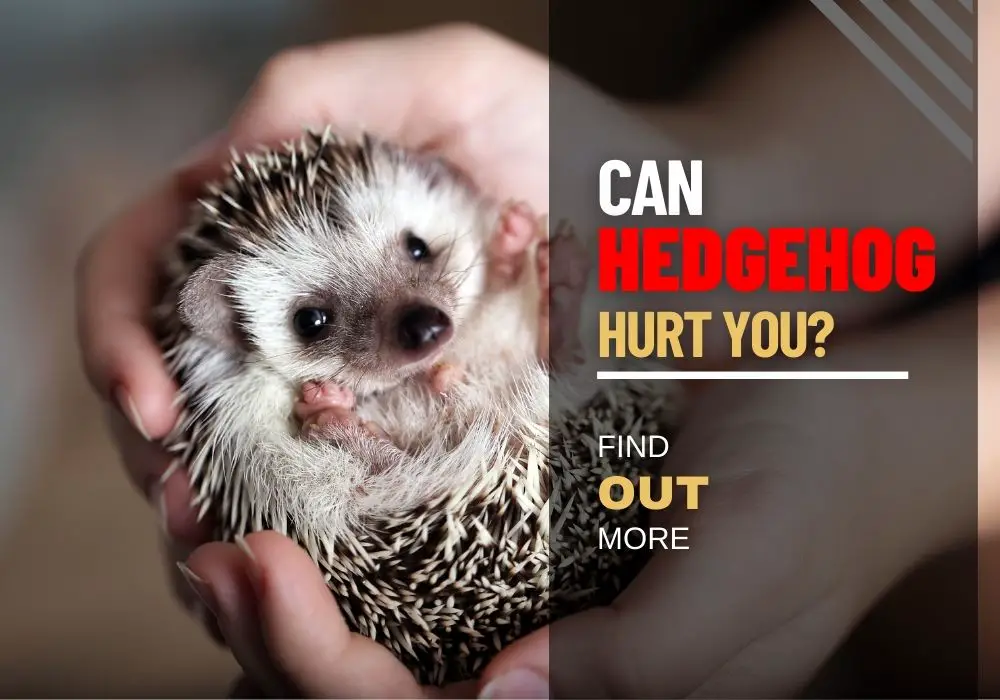Yes, hedgehogs may hurt you, but it depends on how you treat them.
Most of the time, hedgehogs are not mean or dangerous animals. Once you and your hedgehog have come to know each other, your chance of being poked by their quills is low. If you find and touch a wild hedgehog, things will be different. Hedgehogs in the wild aren’t used to being around people so they might be shocked by a sudden encounter. They might use their quills to protect themselves, which could hurt you. For anyone attracted by these lovely creatures and curious about their behavior, particularly defensive actions, join us. We explore here the topic “Can A Hedgehog Hurt You?”. Let’s look around together in this exciting and helpful blog.
Table of Contents
Understanding The Hedgehog

Hedgehogs are small, nocturnal mammals notable for their unique quills made of keratin, similar to human hair and nails. They have 5,000 to 7,000 quills that can vary in colour and are 1 to 2 inches long. Unlike porcupines, their quills don’t easily detach but can be raised defensively. Hedgehogs have soft fur on their faces, underbelly, and legs. They are solitary and use a distinctive defence mechanism of curling into a ball, protecting their delicate parts with quills pointed outward. This behaviour and hissing or “anointing” themselves with frothy saliva helps deter predators. As insectivores, hedgehogs primarily feed on insects, snails, and small creatures, often aiding in garden pest control.
Common Hedgehog-Related Injuries
While hedgehogs are cute and popular pets, treating them incorrectly can cause a range of accidents and health issues in people. To keep the person and the hedgehog safe, knowing about these risks is essential.
Injuries Caused by Hedgehogs
Pokes with quills: The hedgehog’s quills are the most usual cause of harm. Hedgehog spines are not sharp like porcupine quills, but they can still prick the skin if the animal is rough-handed or rolls up in defence. Even though these injuries are usually not too bad, they can be painful and cause an infection if not cleaned and handled correctly.
Bite: Hedgehogs can bite if they feel scared or attacked, but it rarely happens. Their teeth are so sharp they can cut through skin and leave holes. There is a chance of getting an illness from any animal bite, so it’s essential to care for the area properly.
Scratches: Hedgehogs dig and climb with their sharp claws. If you don’t handle them carefully, their claws can scratch the skin, leaving minor cuts that could get infected if you don’t clean them properly.
Infections and Diseases

Some illnesses and diseases, like Salmonellosis, Ringworm, and Mycobacterteriosis, can be passed from hedgehogs to people. This is an example of a zoonotic disease. Both public health and veterinary medicine must keep an eye on zoonotic diseases and illnesses that can be passed from animals to people. The cases of hedgehogs spreading diseases to people make a few critical points about zoonotic diseases:
How the health of people and animals is linked
“One Health” is becoming increasingly well-known in the medical and animal circles. It stresses how the health of people, animals, and the world are all linked. When animals, particularly dogs or animals close to people, get sick, it can directly affect people’s health. Because everything is connected, how we take care of, treat, and handle the health of the animals around us often affects our health.
How important it is to practice good hygiene and handling
The fact that zoonotic diseases can be passed from pets like hedgehogs to people shows how important it is to keep clean and be careful when touching animals. This means washing your hands well with soap and water after touching dogs, keeping their cages clean, and staying away from their poop. These actions are necessary to stop infectious diseases and keep pets and their owners healthy in general.
A Wide Range of Zoonotic Diseases
Zoonotic illnesses can be transmitted from animals or places to people.
They are found in many animals, from pocket pets to wild animals, and can affect people in many places around the world. This wide range means that people and animals must be aware of and take precautions whenever they come into contact with each other, whether at home, on the farm, or in wildlife areas.
Effects on public health
It is awful for public health when diseases are spread from hedgehogs and other animals to people. It shows how important it is for doctors, vets, and public health workers from different fields to work together to deal with zoonotic diseases effectively. Monitoring, studying, and educating the public are all essential parts of a complete plan to control and stop these diseases.
Are the spines of hedgehogs toxic?
Hedgehog spines are not deadly, even though many people think they are toxic. Hedgehog spines are vital to their defence. They transformed hairs composed of keratin, found in hair and nails. The main job of these spines is to guard the hedgehog. When it senses danger, it rolls into a tight ball with its spines sticking outward, making a solid wall against predators. Even though the spines can puncture cuts if a hedgehog is poorly treated or feels threatened, there is no chance that venom or poison will be spread through these wounds. This defence works because the spines make a physical barrier, not because they contain poisonous chemicals.
What’s wrong with touching a hedgehog?
These stiff, sharp spines on hedgehogs’ fur are their primary defence against animals that might try to eat them. When hedgehogs feel threatened, they curl into a small ball, and their spines stick out in all different directions. This makes it hard for animals and people to touch or hold them without getting pricked, which could be painful.
Even so, it’s not true that you can’t touch a hedgehog. People who own and care for hedgehogs often learn how to handle them carefully so the spines don’t hurt them. Should you want to slow down a hedgehog, you can gently stroke it in the direction that its spines grow. This will make its spines flatter. Hedgehogs can also get used to being touched by people if handled often from a young age. This makes them less likely to feel frightened and roll into a ball.
Can I touch a wild hedgehog?

Many risks can happen if you try to touch a wild hedgehog. These risks can affect both you and the hedgehog. Hedgehogs have spines on their bodies to protect themselves, but they can hurt or even puncture cuts if not appropriately treated.
These spikes have no poison or sting, but they can be very sharp. In addition to the pain that might happen, there is also the chance of spreading disease. There is an extra risk when people associate with wild hedgehogs because they may carry diseases and bugs, like salmonella, that can be passed on to people.
It can be awful for the hedgehog’s health to be touched because it causes it stress. When wild animals get close to people, they often feel stressed, which can harm their health. In addition, hedgehogs aren’t usually mean, but if they feel threatened, they might bite with their sharp teeth as a last option.
Will my pet hedgehog hurt me?
Hedgehogs, as pets, usually don’t pose a significant threat of harm to their owners as long as they are treated carefully and correctly. People know hedgehogs for their sharp quills, which can prick your skin if you handle them roughly or if the hedgehog feels threatened and curls up to protect itself. One difference is that these quills are not spiked like a porcupine’s, and the prick is not very painful.
How to avoid hedgehog harm?

Handling and playing with one may be fun with care and knowledge about hedgehog requirements and behaviours. How to engage safely and enjoyably with your hedgehog.
| Gentle Approach: | Move carefully and allow the hedgehog to become used to you to prevent shocking it. A scared hedgehog will curl up. |
| Position Your Hands: | Put one hand under your stomach and support your back and bottom with the other hand. This gives hedgehogs confidence and prevents falls. |
| Avoid pricks: | Hedgehog quills are sharp. Until you become used to handling, gloves may assist. The hedgehog’s quills will flatten with practice, making it more straightforward to handle without gloves. |
| Support their feet: | Hedgehogs relax better with solid footing. Your hands should support their tiny feet. |
| Avoid Sudden Movements: | Move slowly to soothe the hedgehog. It may curl up from sudden movements. |
| Start Early: | Socialize a hedgehog as soon as you bring it home. Younger hedgehogs learn to handle faster. |
| Handling: | Be kind and consistent. Try everyday engagement, even for a few minutes. It familiarizes the hedgehog with human scent and touch. |
| Voice Familiarization: | To get your hedgehog used to your voice, talk to it in a soft, calm voice. It builds trust and recognition. |
| Treats and Toys: | Reward your hedgehog during handling. Playing with toys can also establish trust. |
| Patience matters: | Socializing a hedgehog requires time and care. Respect their boundaries and follow their lead. |
Conclusion
The blog answers, “Can a hedgehog hurt you?” by stating that hedgehog quills can injure, but careful handling and care lessen this danger. Understand hedgehog behaviour, handle gently, and create a stress-free environment for the pet. The site stresses the necessity of knowledge for potential hedgehog owners to guarantee a safe and pleasurable connection.
FAQ
Do hedgehogs have teeth, and can they bite?
Yes, hedgehogs do have teeth and can bite. However, they bite only when frightened or afraid and are usually not aggressive. Though not dangerous, their bites can be unpleasant.
What should I do if the hedgehog quills sting?
Wash away hedgehog quill stings with soap and water to avoid infection. Another option is a mild antiseptic. If you experience an illness or severe response, visit a doctor.
How do hedgehogs show fear?
Hedgehogs may hiss, curl up, or puff their quills when threatened. If you see these behaviours, let the hedgehog settle down before handling it again.
Can kids manage hedgehogs?
Children can safely handle hedgehogs under adult supervision if trained gently and politely.
How do I know if my hedgehog is comfortable with handling it?
A calm hedgehog may uncurl and be curious about its surroundings. It may smell gentle without hissing or puffing its quills. Consistent, compassionate treatment can make your hedgehog trust you.
Is it safe to kiss or nuzzle a hedgehog?
Even though hedgehogs are cute, you shouldn’t kiss or pet them because you could spread diseases only found in animals. Always wash your hands well and avoid touching your face directly with your hedgehog.






Leave a Reply